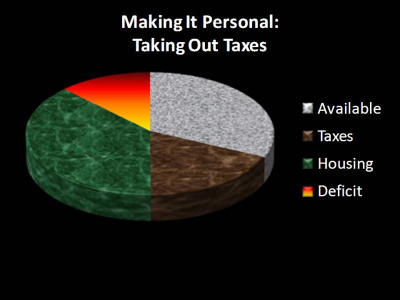Inflation Supply Shock Inferno
(Crisis & Globalization II)
Daniel R. Amerman, CFA
Overview
The gasoline for rampant inflation already permeates the US economy – and all it will take is one bad day for a series of interrelated supply shocks to set off an inflationary inferno. As we will cover in this article, the accelerant in this case is the $700 billion annual United States trade deficit. We’ll explore how the real world economics of being the world’s largest debtor in a globalized economy trump insular deflationist monetary theory, as well as what happens when you pit exogenous supply shocks against Santa Claus.
Some Radical Questions
What would happen if the United States had to actually live on what we all produce? What would happen if other nations would only provide us with the goods and services that we could pay for with our own goods and services? What if other nations stopped manipulating the value of the dollar, stopped propping it up, and let it find its free market value?
This idea of living within our means –whether we want to or not – is radical stuff, but it could be happening fairly soon given the current global economic situation. As we explored in more detail in the companion article / video, "A Plunging Standard of Living (Crisis & Globalization I)", when we divide a $700 billion trade deficit by 111 million US households, the shortfall between what we produce and what we consume comes to about $6,300 per average family. As the median US income is $50,000 per household, this means that an average of 12% of the national standard of living consists of goods and services that we don’t produce enough to pay for, and are supplied effectively on credit by the rest of the world. When we adjust out taxes and the cost of housing, for a loose measure of discretionary income, that means that for the median household about 28% of what we think of as our standard of living is arguably based upon other nations propping up the dollar, manipulating currency values so that effectively American jobs have gone overseas.
In this article, instead of talking about our standard of living, we're going to talk about the purchasing power of our savings – the value of the dollar. What would be the impact if the trade deficit stopped, if supply had to meet demand, and we had to actually pay full price for everything that we are consuming?
Where exactly the dollar would end up is a very good question. But for right now I think it's fair to say that dropping 30% and 50% might be appropriate, for illustration purposes. The dollar has been propped up for a very long time, we have a $700 billion annual trade deficit, and arguably, the single strongest part of the dollar is a psychological factor. The world sees the dollar as the global reserve currency. If the perception goes from reserve currency to fatally wounded dollar, the downward plunge could be deep, and near instantaneous.
The Inflationary Supply Shock Inferno
What happens to prices? Let's look at Wal-Mart, Target and Best Buy. What all those "big box" stores have in common is that they are stacked full of goods made in China, Japan and other nations – for which the United States can't really pay. Goods that we're only able buy because they're buying our treasury bonds in exchange, essentially propping up our trade deficit by paying for our budget deficit. Now, if the dollar drops in half, that means the cost of virtually everything that we buy in those stores would double overnight.
Instead of paying $1,000 for an HDTV – we’re suddenly paying $2,000.
Instead of paying $3 for a plastic spatula - we're suddenly paying six dollars.
Instead of $70 for a dish set - all of a sudden it's $140. We have an immediate, drastic inflationary price shock, with the prices for everything we bring in from overseas soaring overnight.
Most importantly, let’s not forget about oil. We have to import most of our oil: imports hit 60% of US consumption by August 2009. It’s quite ironic, really. Every day, the city streets and interstate highways of the United States fill up with the largest fleet of massive, gas-guzzling vehicles in the world. Yet, we produce neither the gasoline to run to them, nor the real goods and services to pay for that gasoline. Ironically, it is the other nations of the world, almost all of whom have smaller fleets per capita, and more fuel efficient vehicles on average, who subsidize the driving habits of the United States by deferring consumption, propping up the dollar, and effectively lending the money to the US through purchasing our government debt and other financial assets.
This is an extraordinarily unstable situation. If there is anything that a long term history of the world shows us, it is that as comfortable and natural as unstable relationships can seem when we are middle of them, equilibrium will be sought by the very fundamentals of economics and human behavior, and the return to equilibrium may be sudden and catastrophic.
If we have to actually start paying our own way, and other countries stop manipulating the value of the United States dollar, then we can expect a sudden rise in the price of oil. Which in turn raises the cost of transportation, heat, energy – and almost everything else.
Instant price shock. Think about the mid 1970s, only permanent this time.
What about food? Even the food we produce domestically heavily relies upon fertilizers, which rely on petrochemicals. Oil price shock means food price shock.
Let’s consider a common shopping trip, of the kind that tens of millions of Americans do every day.
Start at the gas station where more than half the oil is imported –inflationary price shock.
Move on to the Wal-Mart filled with imported goods that can’t be paid for on a national basis – inflationary price shock.
Next to the Best Buy big box electronics store, also filled with imported goods that can’t be paid for on a national basis – another inflationary price shock.
And finally to the grocery store, filled with drastically more expensive imported foods that rely on oil for transport and domestic foods that rely on petrochemical-based fertilizers – still another inflationary price shock, for four external supply based inflationary price shocks in a row, on all four stops.
If you want to use the technical term for what I've just been describing, they are what is known as “exogenous supply shocks”.
A series of interrelated exogenous supply shocks can set off a chain of events that will lead to an economic forest fire growing out of control. Each place the fire spreads sets off the places next to it. As the fires combine their strength, the flames grow hotter still, and spread to still more places, until there is an inferno. This inferno then creates the most dangerous part of inflation: inflationary expectations. Supply shocks can come and go, but once people incorporate inflation into their behavior, this sets off a chain of events that can go beyond the control of the government and the central bank. There was about a 7 year lag between when the inflationary exogenous supply shock of the oil embargo of 1973-74 hit an already inflationary American economy, and when inflation peaked in 1980-81. Inflation creates its own fuel once external supply shocks ignite the fire.
The Silver Lining For Jobs
There is a very powerful silver lining to collapsing the trade deficit, although the short-term costs may be higher than most people want to pay. And that is that the jobs start to come back to the United States. Not because of trade protectionism, but because the dollar is no longer being supported, and it no longer makes sense to hollow out our economy. It may become cheaper to actually produce textiles in the United States again, and shoes and so many of the things that we all use day-to-day, that are being produced overseas.
Now, as desirable as that is, and as much as that needs to happen from a fundamental basis, there are some real costs associated with that. We can expect to pay higher costs as long as US workers are earning a living wage. We can expect to pay higher costs for raw materials and energy that are brought in from outside the country. There will also be higher costs for maintaining US environmental standards. And when you add all this together, then yes, the jobs are coming back, but we're going to be paying substantially more for every product produced in the United States.
The Santa Claus Theory Of Deflation
Many people are predicting deflation over the coming years. One of the biggest problems with deflation theory, is that it at least implicitly assumes that the more screwed up the US economy gets, the more other nations will find the US dollar to be irresistible. For what domestic price deflation means in a globalized world is that it takes fewer and fewer US dollars to buy goods and services.
Implicitly then, deflation theory assumes that the weaker the US economy gets, triggering domestic deflation, the more other nations around the world will step up to pick up the slack, and send us the goods and oil that we can’t pay for in exchange for fewer and fewer dollars. Now, these other nations are themselves likely experiencing economic problems, and for them to export to the US for less and less compensation, while their economy is producing less overall, means they are ratcheting down their own standard of living at an increasing rate to put a floor underneath the US standard of living. So the implicit deflation assumption is that the poorer and weaker the US becomes, the more of their standard of living the rest of the world will be willing to sacrifice, in order to subsidize our standard of living.
How stable do you think that relationship will be?

We’ll call this the Santa Claus theory of deflation, and it truly is implicit because most deflationists are looking at internal factors rather than the trade deficit. If Santa Claus doesn’t deliver – then deflation theory doesn’t play out, not when we’re talking about consumer price levels. Real world economics for the world’s largest debtor nation trumps monetary theory every time.
There are some who might say that downward pressures on US real estate and other assets will represent a force too powerful to be overcome by external supply shocks. If this is a concern of yours, then it is vital for you to understand that this is a FALSE CONFLICT caused by oversimplification, and that asset deflation is a quite different matter than price or monetary deflation. Indeed, the most common scenario for a debtor nation in deep economic trouble is SIMULTANEOUS price inflation and asset deflation in purchasing power terms – much like Iceland is experiencing today, and Argentina and others have experienced in the past. If you have not already done so, reading my short article “Can Theory & Jargon Threaten Your Net Worth?” may be an essential financial aid for you, with much more information available in my “Puncturing Deflation Myths” series, including why the US depression of the 1930s is a very poor guide for today.
Taking Personal Action
To understand the real extent of the danger, we need to understand that the US trade deficit, along with this artificial propping up of the dollar and our standard of living, hasn't occurred because other nations like us. No, they've been building their own economies by hollowing out the US economy, and they really don't want to have this collapse over a period of days or weeks because of the damage to their own economies. That said, this is a highly unstable situation and the world is in chaotic economic times. All it takes is one very bad day in the currency markets and that could set off a chain of events that would be almost impossible to contain.
So what’s a person to do? One possibility would be to make more money than they ever have before in their life. That was the other thing about the 1970s – tens of millions of people had real wealth redistributed to them, and very few of them understood what happened. What most people don’t understand even today is that what happened in the 1970s was simultaneous monetary inflation and asset deflation.
If actual history is what matters to you rather than theoretical discussions, then the 1970s are one part of a long history of what happens with nations in severe economic distress, when they have a symbolic, independent currency (not gold-backed or explicitly tied to another currency). Real history isn’t one of those fiat currencies soaring in purchasing power, despite the best efforts of the economically wounded nation to keep that from happening. No, the very well established pattern is that the currency collapses in value (price inflation), even as the purchasing power of assets is collapsing (asset deflation), much like what is happening with Iceland today.
That collapse in the value of the currency necessarily forces a major redistribution of wealth, and the segment of the population that is most devastated by this seems to always be the same. It’s the retirees, and the people close to retirement. When we look to Germany, when we look to Argentina, when we look to Russia – it is the pensioners who are impoverished more than any other group.
Unfortunately, history is repeating itself again. When we look at the headlines about the destruction of retiree investment values, pension assets and so forth, we're really just seeing the beginning. Because the crisis "solution" that is being chosen, which is creating dollars without the ability to pay for those dollars, essentially represents the annihilation of most of the retirement dreams of the baby boom generation, even if that is not yet recognized. There is not an even cost that is being born by society as a whole, rather some segments are bearing much more of the burden than others. If your peer group (particularly Boomers and older) is headed for disproportionate financial devastation, then happenstance is unlikely to offer a personal way out. Instead, you must instead take quite deliberate actions to change your personal financial position so that wealth is redistributed to you, rather than away from you.
To get out of step with your generation, and have wealth redistributed to you even as your peer group is being devastated by this extraordinary destruction of wealth, you need to start with an essential and irreplaceable step: education. You need to gain the knowledge you will need to turn adversity into opportunity. This will mean looking inflation straight in the eye and saying: “Inflation, you are likely to play a big role in my personal future, and instead of ignoring you or thoughtlessly flailing away at you – I will study you and your ways. I will learn the deeply unfair ways in which you redistribute wealth, and the counterintuitive lessons about how some investors will be destroyed by inflation and repeatedly pay taxes for the privilege, even while other investors are claiming real wealth on a tax-free basis. I will learn to position myself so that you redistribute wealth to me, and the worse the financial devastation you wreak – the more my personal real net worth grows. I will examine the official blindness to inflation within government tax policy that creates the Inflation Tax, and instead of raging or despairing, I will understand that a blind opponent is a weak opponent, and I will take advantage of your blindness and use tax policy to multiply my real wealth.”









